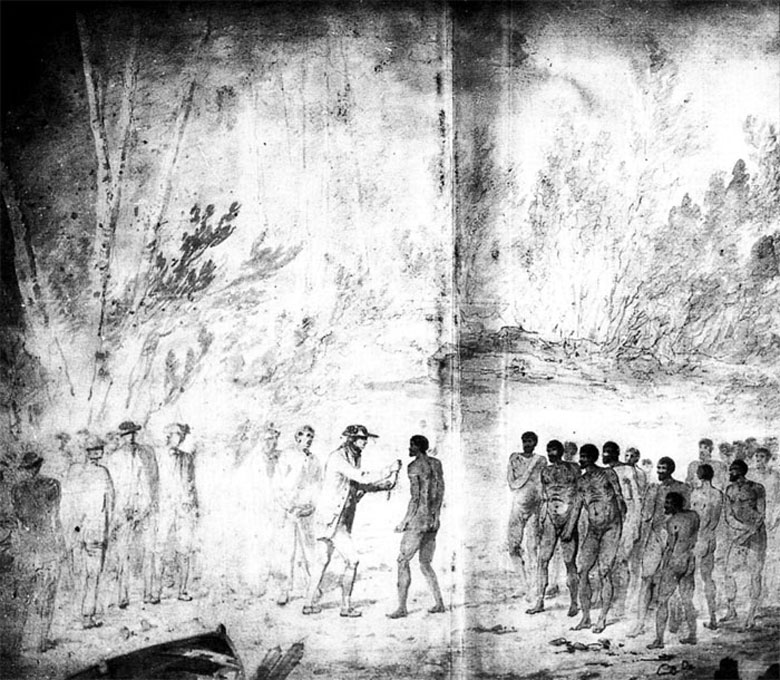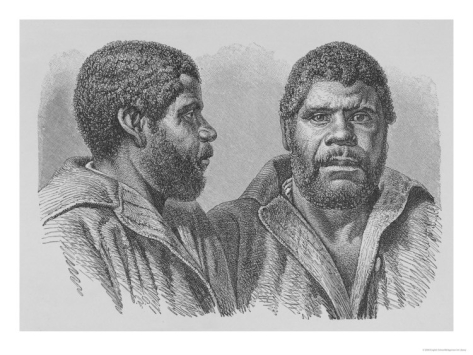…Inevitably, this forceful community, gradually spreading from its seashore settlements, came into contact with the elusive aborigines of the forest. It was known from the start that they existed. When Dutch sailor Abel Tasman arrived off the southeast coast in 1642, he sent a boat into Blackman’s Bay; its crew saw nobody, but heard “certain human sounds” and “sounds resembling the music of a trump or a small gong.” The races first met face to face more than a century later, when the French navigator Marion du Fresne anchored in the Derwent estuary. His crew found a group of natives on the shore, and an indeterminate squabble ensued; the Tasmanians threw stones and spears, and the Europeans responded with gunfire, killing one aborigine, wounding several others, and sending the rest astonished into the woods, “howling fearfully.”

—All Tasmanians went naked and wore no ornaments, but they did have what appeared to be ornamental scars, large ridges raised on the skin. As Cook noted:
(They are) of the common stature but rather slender; their skin was black and also their hair, which was as woolly as any native of Guinea, but they were not distinguished by remarkable thick lips nor flat noses, on the contrary, their features were far from disagreeable; they had pretty good eyes and their teeth were tolerable even but very dirty; most of them had their hair and beards anointed with red oinment and some had their faces painted with the same composition.
Even though Cook admired “hard primitives”, he did not think the Tasmanians had “sufficient civilization” to justify their continued occupation of their island. Instead he felt that the land was “practically unoccupied” since there was no evidence of religion or cultivation of the soil or of a settled law. In his view this made the land “unoccupied” and he did not think the Tasmanians would oppose European settlement. Cook’s view remained accepted wisdom in regard to the Tasmanians among the British – until the British found out how mistaken they were when they tried to occupy and settle the island after 1803.
above:
Captain Cook’s meeting with Tasmanians on 29 January 1777 (by an unknown artist on Cook’s crew).—Read More:http://www.andaman.org/BOOK/chapter52/text52.htm
In 1777 the incomparable Captain Cook made a happier contact with a party of natives on the offshore island called Bruny- they seemed, he recorded, neither afraid nor distrustful. Captain Bligh of the Bounty also liked them, when he landed on Bruny in 1788, and the Frenchmen of Nicholas Baudin’s expedition, in 1802, seem to have been enchanted by them.
We read of aborigines clearing paths for the visitors, sharing their food, greeting them with “cries of joy” and “extremely quick stamping of the feet.” The only trouble occurred when sailors made advances to native women; at all other times the Tasmanians seemed a shy, hospitable, rather sentimental people.
“This gentle confidence of the people in us,” wrote Francois Peron, “these affectionate evidences of benevolence which they never ceased to manifest towards us, the sincerity of their demonstrations, the frankness of their manners, the touching ingenuousness of their caresses, all concurred to excite within us sentiments of the tenderest interest.”

—William Lanney, the Last Tasmanian, The History of Mankind, Vol.1, Prof. Friedrich Ratzel, 1896—click image for source…
These were educated observers in the age of Rousseau, yearning for noble savages. Perhaps they were romanticizing the encounters somewhat, but it remains that these meetings were evidently enjoyable to both sides. The Europeans felt no threat from the guileless primitives. The aborigines thought the peculiar pale strangers might be ghosts of their own dead, and may have welcomed their appearance as a break in the immemorial monotony of hunt, sex, and corroboree. ( to be continued)…
ADDENDUM:
(see link at end)…It was four years later when Captain Cook returned to Tasmania on his third voyage in the southern regions with two vessels the “Resolution” and “Discovery”. At 4pm, 26th January 1777 he dropped anchor about a mile off shore from Adventure Bay. He left four days later heading for New Zealand. It was the first time that an Englishman visually observed the local natives commonly called Tasmanian Aborigines. He compared them to the natives of New Guinea, while his surgeon, Mr Anderson had dialogue with them. He commented, that they “seemed mild and cheerful, without reserve or jealous of strangers.” Cook also had personal contact and wrote that he regretted that he was unable to understand the language. Cook left the land and returned to his ship. However, Lieutenant King, as head of the party left behind in Cook’s absence, witnessed the native men being joined by women and children. King thought some of the young women were “pretty” and the children “extremely so”. Read More:http://members.iinet.net.au/~rwatson1/britishheritage/BRITISH%20HERITAGE%20OF%20TASMANIA.pdf
…Captain Nicolas Baudin had originally sailed for VDL, leaving France late 1800. The voyage, however, was wrought with bad decisions, desertion and sickness. Naturalist Francios Peron who sailed with Baudin and who visited to our shores proved that the voyage was to be of enormous value in both its scientific value and observation of the native race, which Peron sketched; a race that within a few decades was lost forever. Contact with the aboriginal people was extensive, from Port Cygnet, Bruny Island and the River Derwent. There was great variation in how the natives viewed and welcomed the French; most times peaceful, but on occasions because of misunderstanding between the cultures, potentially dan
us. They did observe how harshly the men treated their women folk. ( ibid)





 COMMENTS
COMMENTS